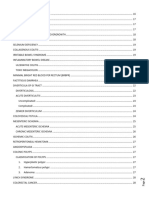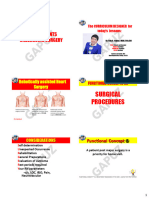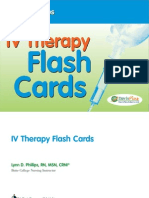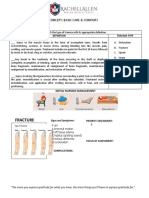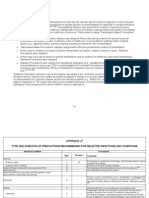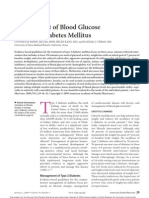Pharma 4 Q
Pharma 4 Q
Uploaded by
MARIA PAULINA AMANTECopyright:
Available Formats
Pharma 4 Q
Pharma 4 Q
Uploaded by
MARIA PAULINA AMANTEOriginal Title
Copyright
Available Formats
Share this document
Did you find this document useful?
Is this content inappropriate?
Copyright:
Available Formats
Pharma 4 Q
Pharma 4 Q
Uploaded by
MARIA PAULINA AMANTECopyright:
Available Formats
www.ragapuzreview.
com
The International Review Centers Network of
The RAY A. GAPUZ SYSTEM
WORKSHOP PRE TEST : Sample NCLEX – style Questions
for
Pharmacology C
By Dr. Ray A. Gapuz, RN,DSc.
Author, ‘NCLEX RN in a Flash’ published by Jones and Bartlett, USA
Author, ‘The ABC of Passing the NCLEX RN’ published by Mosby-Elsevier
1. Levodopa is prescribed for a client with Parkinson’s disease. The sign or symptom that would be unrelated to
the administration of levodopa would be:
a. Nausea b. Anorexia c. Bradycardia d. Mental changes
2. L-Deprenyl (Eldepryl) is prescribed for a client with Parkinson’s disease who had a poor response to levodopa
therapy. When teaching the client and family about this drug, the nurse should explain that:
a. If a severe headache occurs it should be reported to the physician immediately
b. The side effects of levodopa will decrease when these drugs are taken concurrently
c. The dosage of the drug can be adjusted daily depending on the client’s response that day
d. Blood studies should be performed monthly to measure therapeutic blood levels of the drug
3. Dexamethasone (Decadron) is ordered for the early management of a client’s cerebral edema. This treatment
is effective because it:
a. Acts as a hyperosmotic diuretic
b. Increase tissue resistance to infection
c. Reduces the inflammatory response of tissues
d. Decrease the formation of cerebral spinal fluid
4. A client is diagnosed as having myasthenia gravis and pyridostigmine bromide (Mestinon) therapy is started.
During the first week of therapy, while the dosage is being adjusted, the nurse’s priority intervention is to:
a. Administer the medication exactly on time
b. Administer the medication with food or with milk
c. Evaluate the client’s psychological responses between doses
d. Evaluate the client’s muscle strength hourly after administration
5. A client with myasthenia gravis is admitted to the emergency room in crisis. To distinguish between
myasthenic crisis and cholinergic crisis the nurse should prepare to administer:
a. Atropine sulfate c. Naloxone (Narcan)
b. Protamine sulfate d. Edrophonium chloride (Tensilon)
6. The physician orders neostigmine (Prostigmin) for a client with myasthenia gravis. The nurse would know that
the client understands the teaching about this drug when the client says:
a. “I should keep the drug refrigerated in a tight container.”
b. “I should take the drug at the exact time specified by my doctor.”
c. “The peak action of the drug occurs 3 to 4 hours after ingestion.”
d. “The drug should be taken between meals to promote it’s absorption.”
7. The nurse teaches the parents of a child on long-term phenytoin (Dilantin) therapy about care pertinent to this
medication. The nurse recognizes that the teaching is effective when they say, “We should:
a. Give our child the medication 2 hours after breakfast and dinner.”
b. Supplement the diet with high-caloric foods and encourage fluids.”
c. Provide oral hygiene, especially gum massage and flossing of teeth.”
d. Observe our child’s urine for the complication of a reddish brown discoloration.”
8. Epinephrine is added to local anesthetic preparations to:
a. Prolong anesthetic action c. Prevent arrhythmias
b. Lower blood pressure d. Increase blood flow to injection site
9. In comparing aspirin to acetaminophen (Tylenol), acetaminophen (Tylenol):
a. Is contraindicated in clients with peptic ulcer disease
b. Is contraindicated in asthmatic clients
c. Is as effective as aspirin for reducing fever
d. Has a stronger anti-inflammatory effect than aspirin
copyright © R.A. Gapuz Review Center, Inc.
You might also like
- 100 Dosage Calculation Practice Problems AnswersDocument12 pages100 Dosage Calculation Practice Problems AnswersTeena Real81% (21)
- Ati Comprehensive Predictor 2019 ADocument51 pagesAti Comprehensive Predictor 2019 Aanahmburu966No ratings yet
- Hesi v2Document125 pagesHesi v2kandiezein88No ratings yet
- NCLEX RN Review For Reduction of Risk PotentialDocument7 pagesNCLEX RN Review For Reduction of Risk Potentialpaulinatia100% (1)
- Modern Drug Discovery Process by Sejal KhumanDocument40 pagesModern Drug Discovery Process by Sejal KhumanSejal khuman100% (3)
- Pedia: College of Pharmacy List of Medicines For Medical Mission Sta. Rosa, San Juan, La Union As of December 11,2018Document4 pagesPedia: College of Pharmacy List of Medicines For Medical Mission Sta. Rosa, San Juan, La Union As of December 11,2018Beverly BagayaoNo ratings yet
- Antepartum 1Document3 pagesAntepartum 1Emily DavisNo ratings yet
- Mental Health Psychiatric Nursing NCLEX Challenge Exam Quiz 1 50 QuestionsDocument102 pagesMental Health Psychiatric Nursing NCLEX Challenge Exam Quiz 1 50 QuestionsAudrey Blanche Ocampo EstoyNo ratings yet
- Archer 1Document577 pagesArcher 1gracesheeba1985No ratings yet
- Pharmacology Exam ReviewDocument3 pagesPharmacology Exam ReviewThe Treasure Chest100% (1)
- All Uworld Notes 2019 Page4 Nclex NotesDocument152 pagesAll Uworld Notes 2019 Page4 Nclex NotesedithamadasuNo ratings yet
- 13 2023 Surgery Revised HandoutsDocument26 pages13 2023 Surgery Revised HandoutswesamNo ratings yet
- The Next Generation Nclex - Strategies For Success With Speaker NotesDocument47 pagesThe Next Generation Nclex - Strategies For Success With Speaker Notesapi-308471999No ratings yet
- Nclex Exam Preview AnswerDocument37 pagesNclex Exam Preview AnswerMarina AmadoNo ratings yet
- Week 1 Care PlanDocument2 pagesWeek 1 Care Planmlc403No ratings yet
- ATI PN COMPREHENSIVE PredictorDocument39 pagesATI PN COMPREHENSIVE Predictorswachira014No ratings yet
- Fundamental HesiDocument76 pagesFundamental HesiSalv FuentNo ratings yet
- GuideDocument5 pagesGuideHu Tao100% (1)
- 6 - FTT & FAS - MergedDocument25 pages6 - FTT & FAS - Mergedrenie3245No ratings yet
- Comprehensive NCLEX-RN Practice Exam #7Document19 pagesComprehensive NCLEX-RN Practice Exam #7milkah mwauraNo ratings yet
- Individual Performance Profile PN Nursing Care of Children 2011 Form BDocument4 pagesIndividual Performance Profile PN Nursing Care of Children 2011 Form BStan Tan67% (3)
- Bsn-Rs-Careplan 2Document9 pagesBsn-Rs-Careplan 2api-520841770No ratings yet
- NCLEX Updates June 2010Document21 pagesNCLEX Updates June 2010erika_datu100% (1)
- Archer DelegationDocument8 pagesArcher DelegationJoanna Ephraim CruzNo ratings yet
- Basic Care and ComfortDocument35 pagesBasic Care and ComfortRebecca TapiaNo ratings yet
- Nursing Bullets Psychiatric 1 1 1Document14 pagesNursing Bullets Psychiatric 1 1 1Phoebe PitallanoNo ratings yet
- New - Generation - Nclex PN - ACTUAL EXAM - 2024 - ExamDocument92 pagesNew - Generation - Nclex PN - ACTUAL EXAM - 2024 - Examerickomusiq7No ratings yet
- IV Therapy Flash CardsDocument353 pagesIV Therapy Flash CardsMarincovici Maria AndreeaNo ratings yet
- SIMCLEX Renal and Genitourinary DisordersDocument7 pagesSIMCLEX Renal and Genitourinary DisorderssandraNo ratings yet
- NCLEX Real QuestionsDocument1,193 pagesNCLEX Real QuestionsceleanahibNo ratings yet
- Med Surg Success 3e A Q A Review Applying Critical... Chapter 3 Cardiac Disorders PDFDocument40 pagesMed Surg Success 3e A Q A Review Applying Critical... Chapter 3 Cardiac Disorders PDFneah1987No ratings yet
- RN Lesson 2 Safety & Infection Control PracticeDocument39 pagesRN Lesson 2 Safety & Infection Control PracticeRuthmarie CatarajaNo ratings yet
- The Gastrointestinal System6132024Document45 pagesThe Gastrointestinal System6132024harinder singhNo ratings yet
- Maternal and Child Health Nursing ReviewerDocument16 pagesMaternal and Child Health Nursing Reviewerjoyce.feir03No ratings yet
- Hesi Management of A Medical UnitDocument2 pagesHesi Management of A Medical UnitAna Bienne100% (1)
- Endocrine 10-Day Post Live ModulesDocument15 pagesEndocrine 10-Day Post Live ModulesPascal St Peter Nwaorgu100% (2)
- NRG 401 PrefinalDocument48 pagesNRG 401 PrefinalIlyka Fe PañaNo ratings yet
- 6 - Basic Care and ComfortDocument15 pages6 - Basic Care and ComfortKristen NateNo ratings yet
- MEDSURG 1 NotesDocument43 pagesMEDSURG 1 NotesNEIL NETTE S. REYNALDONo ratings yet
- Next Generation NCLEX 3Document41 pagesNext Generation NCLEX 3Alex CampNo ratings yet
- 3 2024 Infection Control Nclex RN HandoutDocument39 pages3 2024 Infection Control Nclex RN Handoutmusiddrisu470No ratings yet
- Basic Care and ComfortDocument74 pagesBasic Care and ComfortNikko Pabico100% (1)
- Hurst Review CDC Infection Control ChartDocument44 pagesHurst Review CDC Infection Control ChartTerry Thun100% (2)
- Pharmacology Fundamental ConceptsDocument84 pagesPharmacology Fundamental Conceptsteaforschool filesNo ratings yet
- Draft: Jurisprudence Learning Module & ExaminationDocument45 pagesDraft: Jurisprudence Learning Module & ExaminationDeepanshi RajputNo ratings yet
- Clinical Case Study - Online Discussion Form Fall 2020-1Document14 pagesClinical Case Study - Online Discussion Form Fall 2020-1Sabrina Odies100% (1)
- Reviewer For The Board ExamDocument40 pagesReviewer For The Board ExamCharina Aubrey RiodilNo ratings yet
- ISBAR Worksheet Olivia Jones Jasgou1752Document1 pageISBAR Worksheet Olivia Jones Jasgou1752Jasmyn Rose100% (1)
- Delegation Cheat SheetDocument2 pagesDelegation Cheat Sheetsdnurse79100% (1)
- 115-NCLEX-RN Review Made Incredibly Easy, Fifth Edition (Incredibly Easy Series) - Lippincott-16083 - p36Document1 page115-NCLEX-RN Review Made Incredibly Easy, Fifth Edition (Incredibly Easy Series) - Lippincott-16083 - p36MuhNatsirNo ratings yet
- 0 Cece's Study Guides Part 2 0 Cece's Study Guides Part 2Document26 pages0 Cece's Study Guides Part 2 0 Cece's Study Guides Part 2Princess Diana Jean ModesteNo ratings yet
- 2023 - PN - Test Plan - FINALDocument56 pages2023 - PN - Test Plan - FINALMuhammad Tahir SaleemNo ratings yet
- Nursing DiagnosisDocument48 pagesNursing DiagnosisLydia Lopz MsnrncdNo ratings yet
- Med Surg Hesi Exit ExamDocument10 pagesMed Surg Hesi Exit Examjwjimmy20No ratings yet
- New Final Revision 27.10.2020Document193 pagesNew Final Revision 27.10.202098b5jc5hgtNo ratings yet
- Inap Cardio Icgb PDFDocument5 pagesInap Cardio Icgb PDFFrances Sofia DuranNo ratings yet
- ClinicalOwl-PharmacologyLastMinuteNotesFullBundleDocument121 pagesClinicalOwl-PharmacologyLastMinuteNotesFullBundleShammah Cecilia NassaliNo ratings yet
- How to Succeed New Graduate Nursing Job Interview & Bachelor of Nursing Clinical Placement?From EverandHow to Succeed New Graduate Nursing Job Interview & Bachelor of Nursing Clinical Placement?No ratings yet
- ZolpidemDocument27 pagesZolpidemAntonio SanchezNo ratings yet
- Bioavailability and First Pass Effect PPTX NEW IADocument18 pagesBioavailability and First Pass Effect PPTX NEW IAFarah NawabNo ratings yet
- Anti-Amoebic Drugs: Madan Sigdel Lecturer Department of Pharmacology Gandaki Medical CollegeDocument21 pagesAnti-Amoebic Drugs: Madan Sigdel Lecturer Department of Pharmacology Gandaki Medical Collegemadan sigdelNo ratings yet
- Anti Diabetic DrugDocument45 pagesAnti Diabetic DrugRahul LokhandeNo ratings yet
- Nama C K Harga # Nama C K HargaDocument11 pagesNama C K Harga # Nama C K HargaHendy Kilat BuanaNo ratings yet
- Administering Oral MedicationsDocument24 pagesAdministering Oral MedicationsRhenier S. Ilado100% (2)
- BP404T, PHarmacology I, Unit 1Document176 pagesBP404T, PHarmacology I, Unit 1Rajni YadavNo ratings yet
- ImplantsDocument26 pagesImplantsbhanu pratapNo ratings yet
- Brand Name Generic Name Dosage Form Opioid AnalgesicDocument3 pagesBrand Name Generic Name Dosage Form Opioid AnalgesicjadeNo ratings yet
- (Faringita Streptococica:copii: 250 MG de 2-3 Ori Pe Zi Adolescenţi Şi Adulţi: 250 MG de 4 Ori Pe Zi Sau 500 MG de 2 Ori Pe Zi Timp de 10 ZileDocument5 pages(Faringita Streptococica:copii: 250 MG de 2-3 Ori Pe Zi Adolescenţi Şi Adulţi: 250 MG de 4 Ori Pe Zi Sau 500 MG de 2 Ori Pe Zi Timp de 10 ZileAlina C100% (1)
- Price ListDocument56 pagesPrice Listmadit farmasi100% (1)
- Apr MicrobialidentificationDocument82 pagesApr MicrobialidentificationAntónio FerreiraNo ratings yet
- AmebiasisDocument16 pagesAmebiasisNagendra NayakNo ratings yet
- Cemaran Dalam ObatDocument32 pagesCemaran Dalam ObatSiska Lisma PebinuariNo ratings yet
- Intravenous Infusion 1Document20 pagesIntravenous Infusion 1كسلان اكتب اسمي100% (1)
- British J Pharmacology - December 1972 - PERTWEE - The Ring Test A Quantitative Method For Assessing The CatalepticDocument11 pagesBritish J Pharmacology - December 1972 - PERTWEE - The Ring Test A Quantitative Method For Assessing The Cataleptictita_leo2No ratings yet
- Synopsis & Viva Questions For Pharmacology I Lab-1Document3 pagesSynopsis & Viva Questions For Pharmacology I Lab-1Praveen Kumar80% (5)
- Appendix B - Product Name Sorted by Applicant: December 2019 - Approved Drug Product ListDocument200 pagesAppendix B - Product Name Sorted by Applicant: December 2019 - Approved Drug Product ListlichenresearchNo ratings yet
- Pharma Industry MKDocument9 pagesPharma Industry MKSasho GjorgjievskiNo ratings yet
- The Safest Drug For Use in Pregnant Women PDFDocument2 pagesThe Safest Drug For Use in Pregnant Women PDFمستر محمودNo ratings yet
- Pipeline of Alzheimers Phase3 PDFDocument5 pagesPipeline of Alzheimers Phase3 PDFArjun GoleNo ratings yet
- Asociere Medicamente Si Clasa FarmacoterapeuticaDocument2 pagesAsociere Medicamente Si Clasa FarmacoterapeuticaEduard MilitaruNo ratings yet
- Lecture 2, Introduction To Pharmacology Continued. (Script)Document11 pagesLecture 2, Introduction To Pharmacology Continued. (Script)JustDen0950% (2)
- Majuro Hospital Drug Formulary 2007: Ministry of HealthDocument23 pagesMajuro Hospital Drug Formulary 2007: Ministry of HealthportosinNo ratings yet
- Research & Development (R&D) - FormulationDocument2 pagesResearch & Development (R&D) - FormulationAliah ZuhairahNo ratings yet
- Principal: Dexa Medica Reg 4: CoverDocument8 pagesPrincipal: Dexa Medica Reg 4: CoverBelza ChristianNo ratings yet
- DM AAFP ManagementDocument8 pagesDM AAFP ManagementphilsguNo ratings yet












